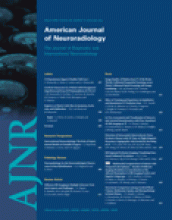Osteogenesis imperfecta (OI) is a heterogeneous group of heritable disorders characterized by increased bone fragility. Typical extraskeletal manifestations (hearing loss, blue sclerae, dentinogenesis imperfecta, and hyperlaxity of ligaments and skin) can be variably associated, but no agreed minimum criteria exist.
The neurologic complications mostly concern skeletal disorders, and the most striking finding is basilar invagination. Intracranial hemorrhage caused by mirror trauma can also occur. OI is associated with type I collagen abnormalities: marked decrease in collagen levels can cause vascular complications such as aortic and cervical artery dissection, carotid cavernous fistula, and ulnar and coronary artery aneurysms. Unlike other connective tissue diseases, the cerebrovascular system is less frequently involved in OI.1 Subarachnoid hemorrhage secondary to ruptured cerebral aneurysm is reported in only 2 cases.2–3
Case Report.
A 44-year-old man was referred for a sudden loss of consciousness. There was no family history of aneurysm, bone fragility, or congenital musculoskeletal disease. He had left femoral and humeral fractures prior to puberty, caused by mirror traumas, and bilateral mild hearing loss. General physical examination also evidenced dentinogenesis imperfecta. The sclerae were normal. Neurologic examination revealed mild coma (Glasgow Coma Scale score, 13), neck stiffness, and mild right hemiparesis. Brain CT showed subarachnoid hemorrhage. Subsequent CT angiography and cerebral digital subtraction angiography (DSA) disclosed a saccular basilar artery aneurysm and a fenestrated left vertebral artery (Fig 1). Guglielmi detachable coil (GDC) embolization of the aneurysm was successfully performed. His symptoms resolved in 10 days. Four months later, follow-up angiography demonstrated a left vertebral-basilar junction aneurysm (Fig 2). The de novo aneurysm was treated with stent placement (Neuroform, Boston Scientific, Natick, Mass) and GDC coiling. After the procedure, the patient continued to be treated with 75 mg of oral clopidogrel and 100 mg of acetylsalicylic acid. At 10-month follow-up, DSA did not depict any new vascular malformation. Genetic testing for OI was performed, revealing a single nucleotide G/C polymorphism of exon 28 of the gene encoding for alpha-2 polypeptide of collagen I.
A and B, Pretreatment angiograms demonstrating saccular basilar artery aneurysm.
A–C, Posttreatment (with GDC and stent) angiograms of the de novo left vertebral-basilar junction aneurysm.
Formation of de novo intracranial aneurysm is rare and most commonly appears in the anterior circulation. Acquired changes in vessel walls, resulting from interaction of environmental factors and several genes, may be an explanation. Hereditary factors are often related to some connective-tissue diseases (Ehlers Danlos syndrome type IV, autosomal dominant polycystic kidney disease, pseudoxanthoma elasticum, and Marfan syndrome). At present, the functional candidate genes code for structural proteins of extracellular matrix, like type III and I collagen, elastin, fibrillin 2, lysyl oxidase, and matrix metalloproteinases. Type I collagen is the major extracellular component of the cerebral arterial wall, with a structural role, and is mainly expressed in the adventitia. OI is commonly associated with mutations for type I collagen genes, possibly causing amount reduction or structural variation. Collagen or genetic testing can be performed for further confirmation of the clinical diagnosis of OI, but up to 15% of mildly affected individuals might still have negative findings. OI type I is also characterized by a 10%–30% of bleeding diathesis, because of deficient production of collagen I, an increased vascular fragility, and impaired platelet function.
We did not identify in our patient any known mutation in COL1A1 and COL1A2 genes, but the analysis revealed SNP28. This most significant allelic association, observed in COL1A2 overexpression, results in an alanine to proline amino acid substitution, determines stability change in collagen I, and may affect the rigidity or elasticity of the vascular wall, causing aneurysm formation. In our opinion, significant vascular fragility may have occurred in our patient with phenotypically mild collagen disease, as confirmed by the association between the functional variant SNP28 and familial IA in a Japanese study.4
- Copyright © American Society of Neuroradiology














